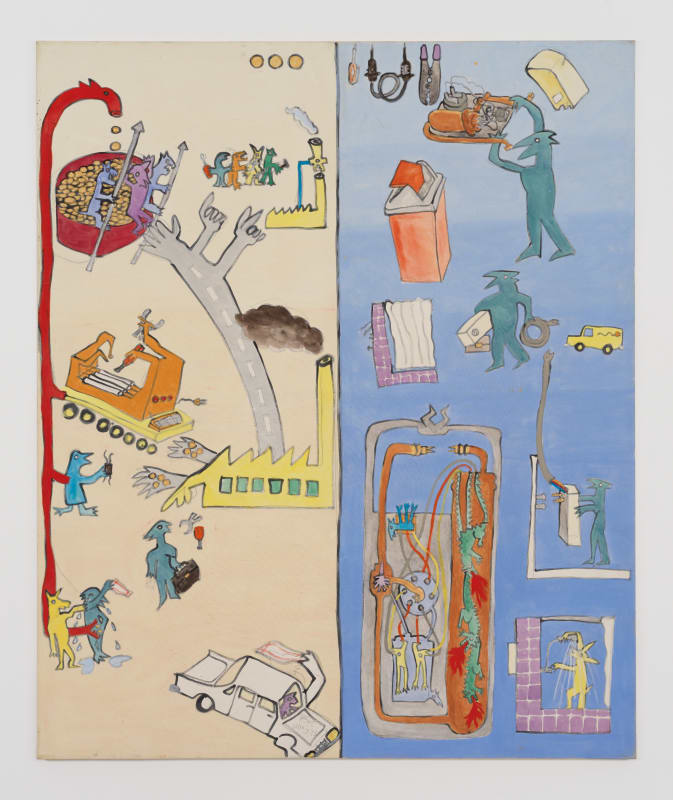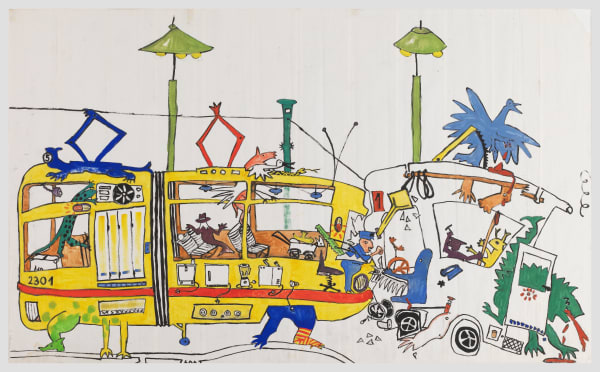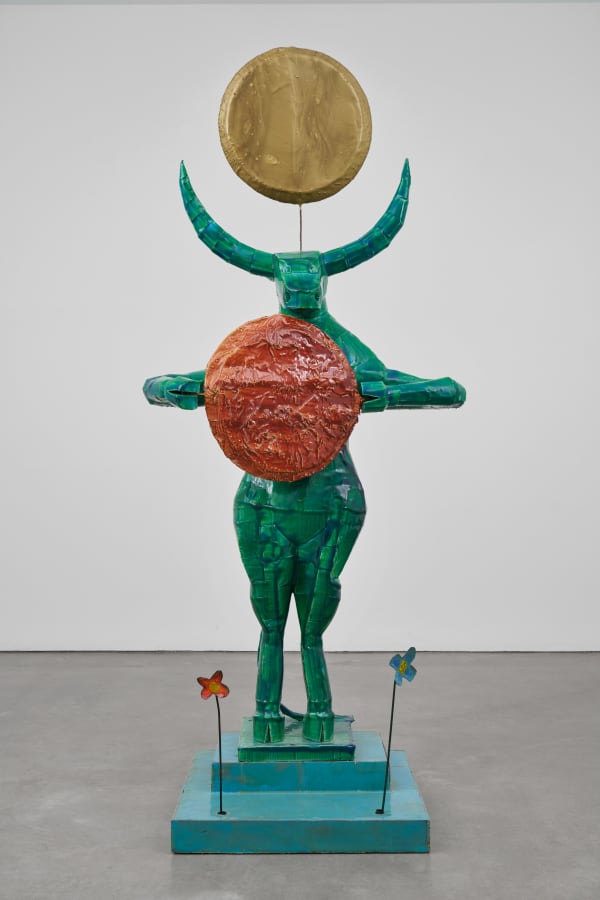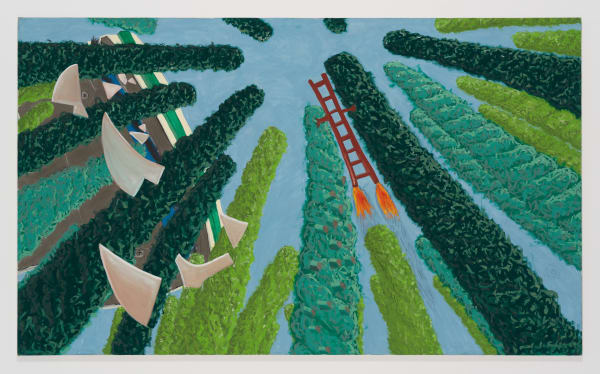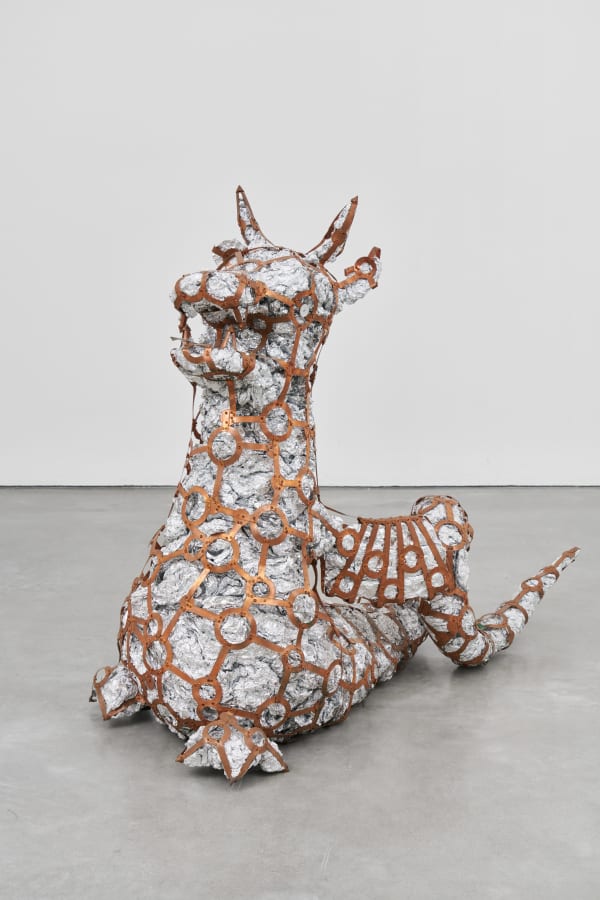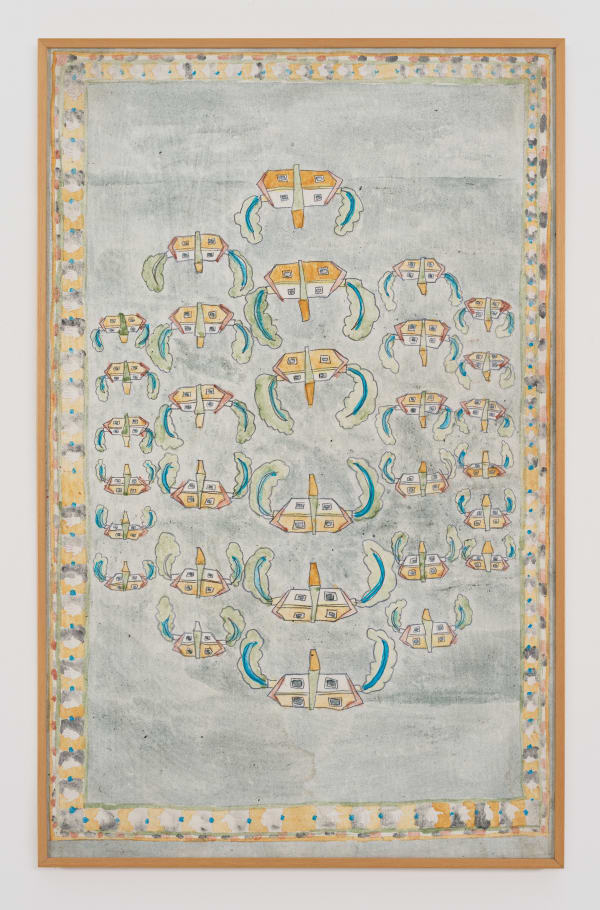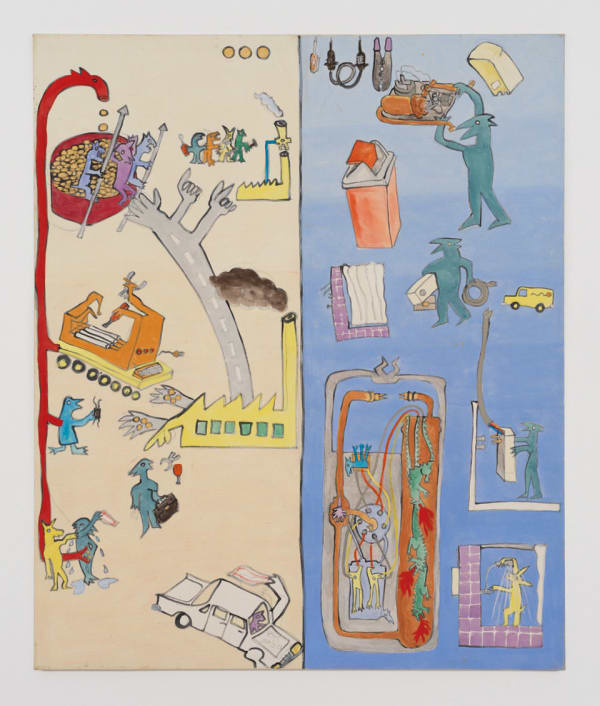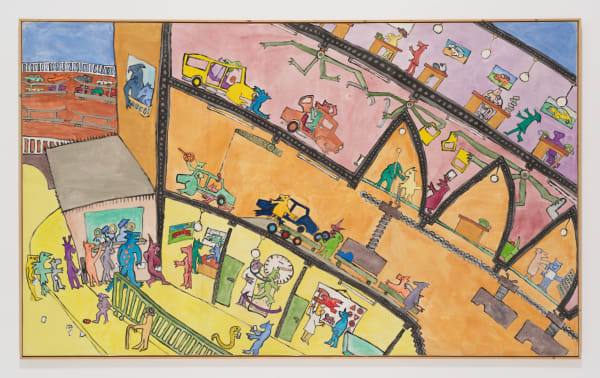Mondkalb mit Reibekuchen : Bertram Jesdinsky
-
Introduction
Myths and motors, carpet landscapes, packed lunches and fantastical creatures – nothing in this world (or beyond it) escapes Bertram Jesdinsky's artistic cosmos. The artist’s pictorial worlds bend time and space, everyday objects seem to take on strange lives of their own, and overpopulated canvases pulsate with life.
Born in 1960, Jesdinsky studied at the Kunstakademie Düsseldorf and later went on to co-found the "Anarchistische GummiZelle" in 1980, which became known for its experimental films and performances. In April 1992, at the age of 32, Jesdinsky took his own life, leaving behind an diverse body of paintings, sculptures, music and films.
The artist Thomas Schütte’s dedicated 2022 exhibition in the Skulturenhalle in Neuss, offered a comprehensive view of his oeuvre. This year, the exhibition Mondkalb mit Reibekuchen, at Galerie Thomas Schulte takes a new look at Bertram Jesdinsky’s artistic life and work. The show illustrates the great autonomy of his work, which is reflected both in the breadth and versatility of the media he employs as well as the uniqueness of his artistic vision embodied in his work.
Jesdinsky began his artistic career outside of traditional art spaces, both in his beginnings as a self-taught artist and later through his interactions with public spaces, on billboards and graffiti. Subverting often elitist discourses, his work instead took a direct and unconventional approach to art, foregrounding everyday images and ordinary life stories. His intentionally simple style of representation offers a playful yet profound engagement with pop culture, myth, and subversive humor. A key example of this style is embodied in his work Mondkalb mit Reibekuchen, which roughly translates to moon calf with potato pancake, first exhibited at the Kunsthalle Baden-Baden in 1989. The hybrid figure references Ancient Egyptian mythology, portraying the guardian figure, Anubis. However, in this image, instead of the head of a jackal, the figure has a cow’s head, and cradles in its hands, a moon-like potato pancake, a quiet homage to German cuisine and everyday life.
Standing awkwardly on a low pedestal, the moon calf conveys a certain vulnerability. The term “moon calf” is a folkloric reference to creatures who have been deformed by the moon. A theme which further reflects Jesdinsky's interest and deep empathy for obscure, marginalized and misunderstood figures, who often appear disguised as technical devices, as tormented motors or struggling kitchen machines within his pictorial universes.
Producing his work largely in the 1980’s, Jesdinsky’s work is born out of an era of both immense artistic freedom and a Western World marked by growing neoliberal consumption and leaden conservatism. In many ways, Jesdinsky’s work offers a profound commentary on the tension between a still healing post-World War II Europe and a world an increasingly digitizing and globalizing world that offered new possibilities of mobility, technological progress and artistic expression. Indeed, his work seems to ask us, whether a world so suddenly interconnected, colorful, and productive can really be trusted.
In a decade marked by the Cold War, neoliberalism, and cultural rebellion—Jesdinsky’s art captures the ambivalence of the era. This sense of ambivalence is palpable in Bertram Jesdinsky’s work, echoing a scepticism which undergirded pop culture at the time. Underground movements like punk and new wave and new Dadaism represented a profound rejection of the status-quo, while critically reflecting an engagement with the socio-political climate. His work thus offers a window into the ways in which artists processed an era marked by rampant growth, change and insecurity.
His whimsical yet critical lens invites viewers into richly layered worlds where animals become heroes, machines become autonomous agents, and time feels elastic. In many ways his work thus embodies the “anything goes” mentality of postmodernism, while still critically engaging with the great social and political upheavals of the time. This new generation, to which Jesdinsky belongs, is not interested in what defines good art nor who defines it.
From his early graffiti and public art to intricate environments like the ephemeral KüMa-Park, Jesdinsky consistently blurred boundaries between “high” and “low” art.
Works like Autofabrik (1987), Geschwindigkeitskontrolle in der DDR (1986) and, importantly, Bus + Bahn (Zusammenstoß) (1982) are key examples of his playful yet sophisticated blending of pop cultural references, media and techniques that seem to move through narratives like the pages of traditional books of fables. Indeed, the narratives which emerge from his pictorial worlds seem to normalize the obscure and absurd: a streetcar with socked feet and claws for wheels, powered by mythical creatures suspended on the power cables above, moves through a street illuminated by floor lamps. Why wouldn’t this make sense?
Nearly every aspect of Bertram Jesdinsky’s artistic practice is permeated with an ingenious dilettantism that resists all smoothness and polish. His work embraces speed and spontaneity, slapstick humor, and inexpensive, readily available materials, reflecting a kind of anti-attitude that rejects the established and conventional. At the same time, Jesdinsky’s profoundly independent oeuvre is not defined by opposition to any external adversary but draws its power and force from within. He is also known for engaging deeply with his audience in ways that play with ideas of scale and agency. Works such as Grüner Teppich (1987) draw the viewer right into the middle of the action, looming like trees over an army of ants.
Though typically solitary figures such as in Mondkalb mit Reibekuchen (1989), Angler (1989), Hirsch (1991) and Basilisk (1992), they unmistakably belong to a shared cosmos—a society meticulously crafted by the artist, where each figure has its place and purpose. Indeed, these figures appear inhabit a parallel world, though one in which viewer might find themselves reflected. At the same time, a distance is created by the animal’s other worldliness which engages the viewers in a way that is both contemplative yet inherently playful. It is precisely the authenticity of Jesdinsky’s artistic vision, his distinctive figures, and the unique iconography he developed that creates enduring fascination that continues to captivate to this day.
Text by Johanna Adam
-
Installation Views
-
Works
-
Inquire about works by Bertram Jesdinsky
-
Artists on view
